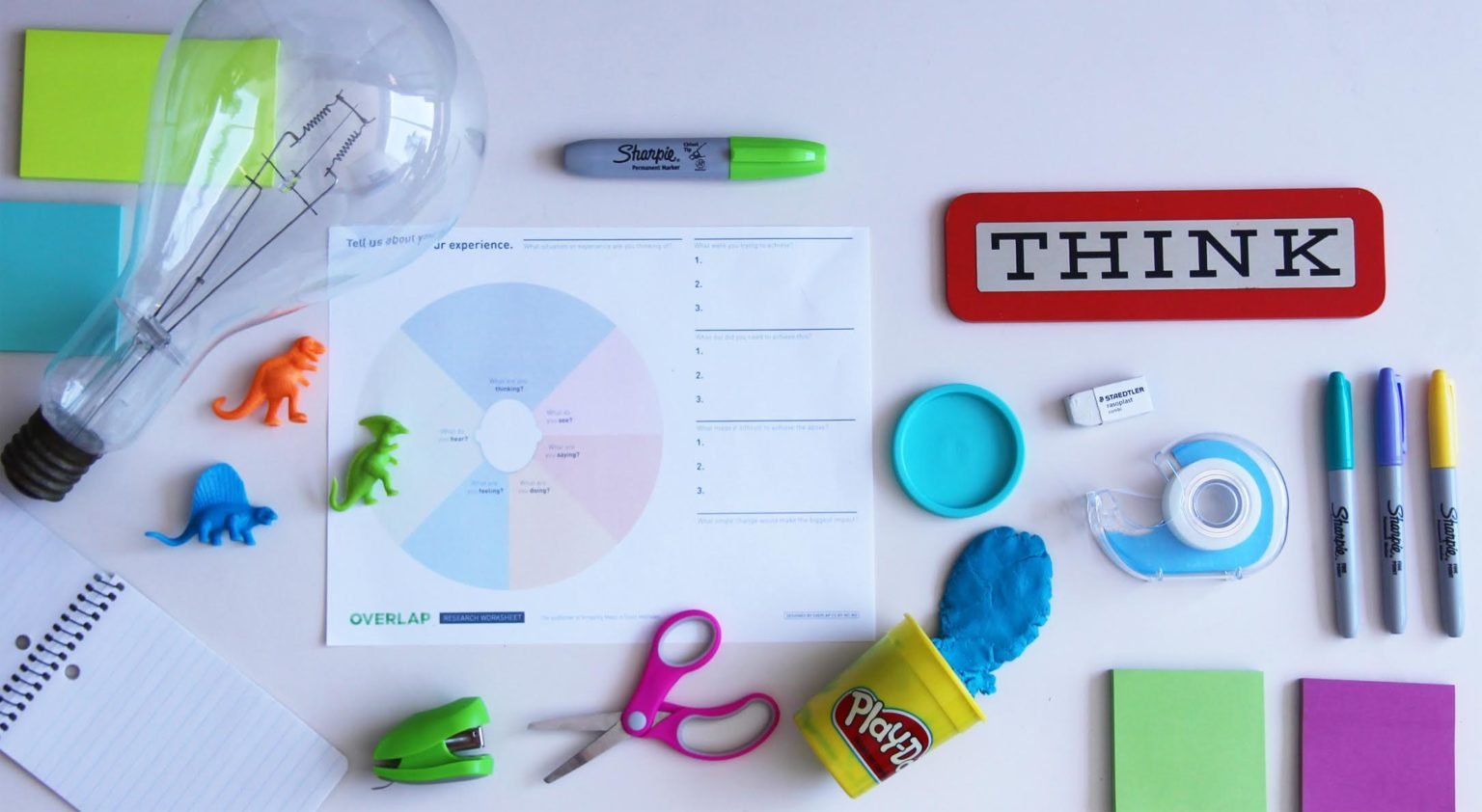15 Free or Nearly Free Design Thinking Tools
Embrace design to reach better results, achieve personal goals, thrive as a team, and improve the world around you.
Design Thinking is a process and mindset that’s human-centred, iterative, and collaborative. Design Thinking methods are accessible to any industry and any experience level so you can get started today.
Begin applying this approach, and reaping the benefits, with the following free design thinking tools.
If you’re new to design thinking, you can learn more with this Introduction to Design Thinking.
1. Empathy Map
An Empathy Map is a worksheet used to conduct empathetic interviews about an experience or problem. They often produce “aha!” moments because they help you empathize with a client or stakeholder’s real experiences, wants, and needs from their own viewpoint.
Download Overlap’s free Empathy Map template.
2. Feedback Grid
With a feedback grid, you can add structure to your feedback by collecting insights that are meaningful and constructive. The tool encourages people to share what they like, what they would improve, questions they have, as well as any additional new ideas. It’s feedback you can use right away.
3. Journey Map
Want to understand the experiences of your customers or stakeholders? Mapping out complete experiences is a worthwhile process that can gather deep insights into people’s needs. Journey maps prompt you or your clients to remember all of the details of an event, including parts that initially may seem insignificant.
Download a Journey Map worksheet.
4. Impact/Effort Matrix
Group your ideas and action items with an Impact/Effort matrix. It’s a quick and effective way to spotlight clusters of high priority ideas. Once completed, your ideas will be separated into four helpful groups, clearly illustrating your priorities. Learn how to use an Impact/Effort matrix.
5. Impact/Power Matrix
Generate a list of stakeholders and map them out on a Impact/Power matrix. The High-Impact stakeholders should be your highest priority when making decisions. Completing this stakeholder analysis helps build consensus in your organization or team about where your efforts should be going.
6. Miro: Virtual Visual Collaboration Tool
Miro is our team’s go-to visual virtual collaboration tool. Get your ideas down and collaborate with your team using Miro’s initiative templates and tools. Create templates for facilitations or workspaces you use often, and take advantage of built-in polling and commenting features. Learn more about Miro and how we use it for online facilitation in our Online Facilitation training.
7. Canva: Prototyping Program
Canva is another prototyping option. The online tool is free and easy to use for novice designers. Canva helps you prototype professional 2D graphics in minutes so that you can begin getting feedback right away.
8. SurveyMonkey: Survey Tool
Want to hear from your customers, stakeholders, or community? Surveys are a great option for reaching a large number of people as a complement to interviews or when more in-depth research methods are unavailable. SurveyMonkey is a good place to start for building general surveys, and the program offers a free basic plan.
9. Typeform: Survey Tool
Typeform is another online surveying option. It allows you to create sophisticated and visually appealing surveys, though it has limitations on accessibility. Typeform is great for younger audiences and offers a limited version for free.
10. Post-it Notes ($)
Post-its begin most of Overlap’s engagement sessions because they encourage people to start solo, an important strategy for ideation. They are an excellent tool for writing down ideas alone, then compiling and sharing them as a group. You can also use Post-its to create calendars, assign tasks, and for Agile project management.
11. Sharpies ($)
The physical act of writing on a sticky note will force decision-making and idea-sharing. A bolder writing tool is extra beneficial because it limits words, which creates clarity. Aim for 3-5 words per sticky to keep ideas concise and clear.
12. Dot Stickers ($)
Use dot stickers to vote on possibilities when you need to make a decision as a group. After everyone understands the options, assign dot stickers (we recommend three) to each person to use as their vote. Let everyone place a dot on their favourite three options. Everyone’s voice will be heard, and in the end, the clusters of dots will highlight the ideas that have the most support.
13. Prototyping Kit ($)
Use a prototyping kit to build ideas quickly in order to receive feedback sooner. Iterating often is an essential aspect of design thinking. Your prototyping kit will help you visualize, create, and share ideas for immediate feedback. What’s in a prototyping kit? Anything you can build with: Play-Doh, popsicle sticks, cardboard, tape, glue, markers, paper, stickers, pipe cleaners and any other miscellaneous crafting supply.
14. Notebook ($)
Acquiring a notebook is inexpensive, and you can use it to take notes, doodle, draw diagrams, and sketch prototypes. Creating your own alphabet is a great way to enhance your visual thinking too. Our Design Thinking notebook includes a reference guide to the human-centred design process, as well as a decision tree to help guide your process.
15. Design Thinking Deck ($)
This deck of cards includes a powerful set of nudges for tackling problems and challenges, big and small. Whether you’re working on improving the waiting room experience at a hospital, you’re a facilitator driven to meet the needs of your clients more effectively, or you work for a company and you’d like to create a better customer experience, the prompts and nudges on these cards can help you get to better.
You can buy your own Design Thinking Deck on Overlap Gear.
Want to learn more about Design Thinking?
Overlap offers a variety of training opportunities for groups or individuals. Whether you’re new to Design Thinking, or a seasoned pro, you’ll find a course to learn more and improve your practice. Learn more about our courses.
Check out the latest from Overlap’s Blog for stories, insights, and industry trends. Or subscribe to hear about recent content and free resources.
Keep Reading:
75 Design Thinking Tools and Resources Explained
How You Can Prepare For The Future Using Strategic Foresight











